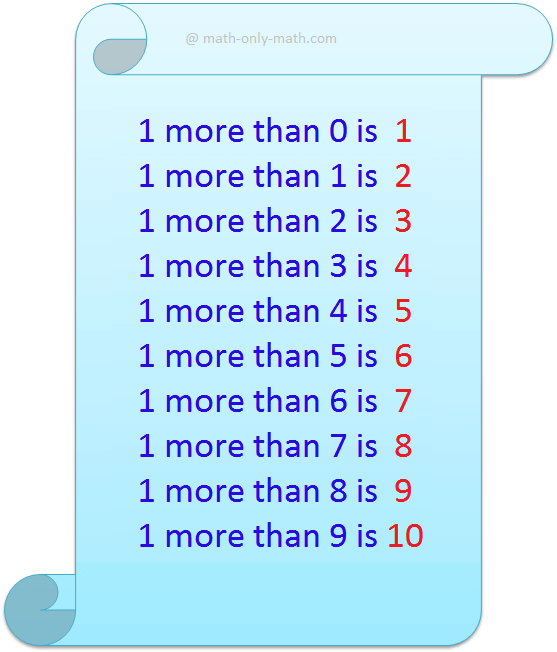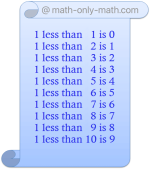Equation of a Line Parallel to a Line
We will learn how to find the equation of a line parallel to a line.
Prove that the equation of a line parallel to a given line ax + by + λ = 0, where λ is a constant.
Let, ax + by + c = 0 (b ≠ 0) be the equation of the given straight line.
Now, convert the equation ax + by + c = 0 to its slope-intercept form.
ax + by+ c = 0
⇒ by = - ax - c
Dividing both sides by b, [b ≠ 0] we get,
y = -ab x - cb, which is the slope-intercept form.
Now comparing the above equation to slope-intercept form (y
= mx + b) we get,
The slope of the line ax + by + c = 0 is (- ab).
Since the required line is parallel to the given line, the slope of the required line is also (- ab).
Let k (an arbitrary constant) be the intercept of the required straight line. Then the equation of the straight line is
y = - ab x + k
⇒ by = - ax + bk
⇒ ax + by = λ, Where λ = bk = another arbitrary constant.
Note: (i) Assigning different values to λ in ax + by = λ we shall get different straight lines each of which is parallel to the line ax + by + c = 0. Thus, we can have a family of straight lines parallel to a given line.
(ii) To write a line parallel to a given line we keep the expression containing x and y same and simply replace the given constant by a new constant λ. The value of λ can be determined by some given condition.
To get it more clear let us compare the equation ax + by = λ with equation ax + by + c = 0. It follows that to write the equation of a line parallel to a given straight line we simply need to replace the given constant by an arbitrary constant, the terms with x and y remain unaltered. For example, the equation of a straight line parallel to the straight line 7x - 5y + 9 = 0 is 7x - 5y + λ = 0 where λ is an arbitrary constant.
Solved examples to find the equations of straight lines parallel to a given line:
1. Find the equation of the straight line which is parallel to 5x - 7y = 0 and passing through the point (2, - 3).
Solution:
The equation of any straight line parallel to the line 5x - 7y = 0 is 5x - 7y + λ = 0 …………… (i) [Where λ is an arbitrary constant].
If the line (i) passes through the point (2, - 3) then we shall have,
5 ∙ 2 - 7 ∙ (-3) + λ = 0
⇒ 10 + 21 + λ = 0
⇒ 31 + λ = 0
⇒ λ = -31
Therefore, the equation of the required straight line is 5x - 7y - 31 = 0.
2. Find the equation of the straight line passing through the point (5, - 6) and parallel to the straight line 3x - 2y + 10 = 0.
Solution:
The equation of any straight line parallel to the line 3x - 2y + 10 = 0 is 3x - 2y + k = 0 …………… (i) [Where k is an arbitrary constant].
According to the problem, the line (i) passes through the point (5, - 6) then we shall have,
3 ∙ 5 - 2 ∙ (-6) + k = 0
⇒ 15 + 21 + k = 0
⇒ 36 + k = 0
⇒ k = -36
Therefore, the equation of the required straight line is 3x - 2y - 36 = 0.
● The Straight Line
- Straight Line
- Slope of a Straight Line
- Slope of a Line through Two Given Points
- Collinearity of Three Points
- Equation of a Line Parallel to x-axis
- Equation of a Line Parallel to y-axis
- Slope-intercept Form
- Point-slope Form
- Straight line in Two-point Form
- Straight Line in Intercept Form
- Straight Line in Normal Form
- General Form into Slope-intercept Form
- General Form into Intercept Form
- General Form into Normal Form
- Point of Intersection of Two Lines
- Concurrency of Three Lines
- Angle between Two Straight Lines
- Condition of Parallelism of Lines
- Equation of a Line Parallel to a Line
- Condition of Perpendicularity of Two Lines
- Equation of a Line Perpendicular to a Line
- Identical Straight Lines
- Position of a Point Relative to a Line
- Distance of a Point from a Straight Line
- Equations of the Bisectors of the Angles between Two Straight Lines
- Bisector of the Angle which Contains the Origin
- Straight Line Formulae
- Problems on Straight Lines
- Word Problems on Straight Lines
- Problems on Slope and Intercept
11 and 12 Grade Math
From Equation of a Line Parallel to a Line to HOME PAGE
Didn't find what you were looking for? Or want to know more information about Math Only Math. Use this Google Search to find what you need.
Recent Articles
-
Word Problems on Multiplication and Division of Fractions | Worksheet
Apr 13, 25 10:09 AM
Here we will solve different types of word problems on multiplication and division of fractions. I. Solve the following word problems on multiplication of fractions. -
One More than Numbers upto 10 | Counting One More | Learn 1 more Than
Apr 11, 25 04:09 PM
1 more than means we need to add or count one more number to the given numbers. Here, we will learn counting one more than upto number 10. Examples of counting 1 more than up to number 10 are given as… -
One Less than Numbers upto 10 | Counting One Less | Learn 1 Less Than
Apr 11, 25 04:07 PM
What is one less than? 1 less than means we need to subtract or count one less number of the given numbers. Here, we will learn counting one less than upto number 10. Examples of counting 1 less than… -
Properties of Multiplication and Division of Fractions Worksheet | Ans
Apr 10, 25 03:17 PM
In properties of multiplication and division of fractions worksheet you will get different types of questions based on properties of multiplication of fractional numbers and properties of division of… -
Word Problems on Fraction | Math Fraction Word Problems |Fraction Math
Apr 09, 25 01:44 AM
In word problems on fraction we will solve different types of problems on multiplication of fractional numbers and division of fractional numbers.



New! Comments
Have your say about what you just read! Leave me a comment in the box below. Ask a Question or Answer a Question.